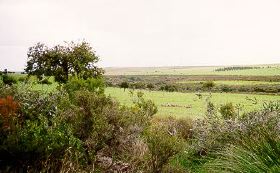
 |
Tributaries to the Lake Warden system |
| Tributaries to Lake Warden System at a glance | |||
| Catchment area: | 157,000 hectares | ||
| Percentage cleared: | 95% | ||
| Data selection | |||

Bandy Creek is approximately 30 kilometres long and drains salt lake country on the sandplain plateau north of Esperance, much of which is cleared for agriculture.
Towards the coast it passes through the swamp and lake system of the Lake Mullet Nature Reserve, where it is joined by other tributaries. To the east, Mt Edward Creek feeds the lake system and to the west, Coramup Creek. It is estimated that Coramup Creek contributes about 7 300 Megalitres/annum, Bandy Creek 7 000 Megalitres/annum and Mt Edward Creek 7 500 Megalitres/annum into the lake system. Water leaving the lake system flows over a drop structure into Esperance Bay, where the estuary has been converted into a small boat harbour. The whole system is a saline throughout.
In 2005 a project (Our Living Rivers) was set up to collect and analyse data, enabling the Department of Water to monitor the health of the river over time and help determine what systems need better protection. In spring 2006 and 2007 samples were taken from the river system to assess the quality of the water and habitat as well as the presence of fish and macroinvertebrates. Two sites were sampled on Bandy Creek, and two on Coramup Creek.
Further Information:
South Coast Regional Land and Water Care Strategy:
The Esperance-Sandplain Sub-region
Prepared by:
the South Coast Regional Assessment Panel and
the South Coast Regional Initiative Planning Team
February 1997